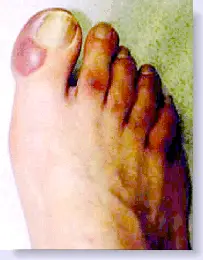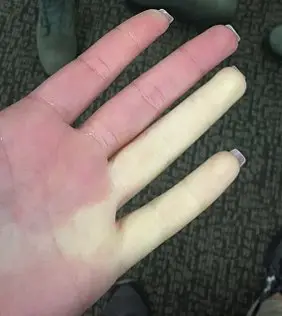cold feet
AUTHOR: Marc Mitnick DPM
home --> cold feet
Cold feet (and hands) is a fairly common complaint amongst patients. This discussion will be limited to people who suffer from cold hands and feet as there is usually a common denominator causing the problem in all extremities.
This section is devoted to the symptoms of cold feet that are not due to a blood vessel blockage. If you are suffering from feet that are cold and appear discolored, may be painful when at rest or when trying to walk a short distance or perhaps burn or tingle, this may be a sign of poor circulation and immediate medical attention is required. Click here for more information on peripheral circulation.
CAUSES OF COLD FEET
In most instances cold extremities can be weather related. Cold temperatures have a constricting affect on blood vessels, which will decrease the flow of blood to the hands and feet. However, there are other factors that will cause these symptoms, these include:
- a poor functioning thyroid
- anemia
- Raynauds disease
- rheumatoid arthritis
- lupus
- high blood pressure
People who have chronically cold hands and cold feet should have a complete work-up to rule out the above-mentioned conditions. Assuming your tests come back normal here is a list of things you can try to improve the situation.
TREATMENT FOR COLD FEET
1.Wear warm clothing. Seems like an obvious statement but one of the problems many people do not realize is that cold weather constricts your peripheral circulation thereby increasing blood flow (and heat) to your torso. By wearing very warm coats and protecting your “body heat” this counteracts the peripheral constricting process. Additionally, wearing warm covering on your legs and feet reduces the exposure to cold on your extremities further negating the effects of cold weather on your system. If you do a lot of walking outdoors in order to get to work, carry your work or dress shoes in a bag and wear warm socks and boots to and from work.
2.Do not smoke. I know this is easier said than done, but smoking causes vasoconstriction on your circulation. Just like exposure to cold, tobacco clamps down your arteries decreasing blood flow to the feet. Worse than exposure to cold, tobacco use over the long haul also increases arteriosclerosis (hardening of the arteries) in your feet and legs, as well as elsewhere.
3.Eat warm food. It is not so much that warm food “warms” you up; it is more that warm food requires less body energy than cold food in order to be digested. This leaves more body energy to help keep you warm.
4.Avoid coffee; drink tea. Caffeinated coffee constricts blood vessels as does all caffeinated drinks, but green and black tea contain flavonoids which help support blood vessel health.
5.Nutritional supplements. Magnesium 1000mg per day relaxes blood vessels and helps promote blood flow. Too much magnesium may cause diarrhea. Hawthorn berry and resveratrol supplements helps maintain the integrity of your blood vessels.
6.Aerobic exercise. Regular exercise such as walking, preferably indoors in cold weather, is a great way to promote better circulation to your feet.
Here in the northeast where we tend to have cold damp winters there are two conditions that I see a lot of related to this discussion.
Superficial frostbite, also known as chilblains or pernio. Most people think of frostbite as a condition that occurs when you are abandoned in the Canadian Rockies for a few days. Believe it or not you can develop superficial frostbite doing nothing more than walking four blocks to work everyday wearing nylons and dress shoes in the middle of winter. I have also seen it in people who work outdoors all day such as construction workers or deliverymen.
Depending on the quality of circulation to the feet to begin with, exposure to cold damp weather will further constrict the blood vessels that go primarily into the toes. This diminishes the blood flow to the skin which starves the skin of oxygen and nutrients. The patient will present complaining of pain in some or all of the toes. There may also be itching. There is usually a blue to red discoloration in the toes. In the slightly more severe case the toes may begin to ulcerate and thereby run the risk of becoming infected.
Below is a picture of superficial frostbite.

|
Treatment obviously is to avoid exposure to cold and to habits that potentiate vasoconstriction of the vessels, eg: smoking. In those individuals who suffer from this repeatedly and have tried all the “easy” solutions I will occasionally put patients on Trental about three months before the winter months in an effort to improve blood flow to the foot. They can stop the medication at the end of winter.
Raynauds disease This is a condition with idiopathic origins. Raynauds phenomenon is the same condition but which is secondary to an underlying disease such as arteriosclerosis, systemic lupus, scleroderma, Buergers disease among others.
Raynauds typically affects females much more so than males. It generally occurs in women in their 20’s and 30’s. Historically, it is seen in women who tend to be anxious and nervous thus suggesting a neurological origin.
The condition is not limited to the feet and hands; it may also be seen on the ears and nose.
Upon exposure to cold stimulus the affected area will undergo a series of color changes. First the affected part will turn pale (white), this represents a vasoconstriction of the small arteries in the area.
Below is a picture of a hand. Notice the how white some of the fingers are.
|
|

|
https://en.wikipedia.org/wiki/Raynaud_syndrome
After a while the affected area will then turn cyanotic (blue). This represents the constriction of the small veins in the area in an effort to keep blood in the area. Finally the area will turn red which will occur when the small arteries in the area relax and blood rushes back into the affected area.
Along with the changes in color, the patient may also complain of burning, tingling, itching, numbness and pain.
Like superficial frostbite the patient is instructed to avoid exposure of their extremities to cold. The difference is that Raynauds can occur in less cold situations than superficial frostbite, so it can occur more often and for longer time periods during the year.
The best way to terminate an attack is to immediately return indoors and place the exposed digits in luke-warm water (109 degrees Fahrenheit). Never use HOT water.
Simple measures as explained above should suffice for infrequent and mild attacks. More severe attacks which lead to skin changes and perhaps ulceration may require oral medication to stem the attacks.
The most commonly prescribed drug is Nifedipine (Procardia, Adalat) which is a calcium channel blocker used to treat high blood pressure and angina. This medicine must be taken under the supervision of your doctor.
Pentozifylline (Trental) is another drug that has been used with success. This medicine is generally used for poor circulation and works by making the red blood cells more pliable so they can "squeeze" through the narrow arteries. This medication needs to be started approximately three months before the onset of winter.
REFERENCES
Want more information? CLICK HERE


Recent Articles
-
Vitamin D impact on health
Feb 06, 23 07:17 PM
Researchers are suggesting that the effectiveness of Vitamin D in fighting and preventing disease is predicated on a persons body mass index (BMI). The thinner the person the greater the positive impa… -
Foods to speed up healing
Feb 01, 23 02:41 PM
One of the best ways to help yourself heal faster after surgery is to eat well. Getting the proper nutrition will provide your body with the essentials it needs to promote healing. Here is a suggestio… -
Cancer and Type 2 Diabetes
Jan 25, 23 04:52 PM
An article revealing that older type 2 diabetics have a higher incidence of cancer then non-diabetics. It is suggested that cancer may surpass CVD as the number one cause of death in older diabetics. -
Does glucosamine or MSM reduce arthritis pain?
Jan 22, 23 01:41 PM
A good review of the possible benefits to taking glucosamine, chondroitin or MSM for arthritis. Always beware of the possible side effects of over the counter supplements. -
shin splints
Jan 18, 23 05:12 PM
A great review on the various causes of shin splints, along with treatment options. -
Whats new in skin cancer?
Jan 15, 23 08:32 PM
A presentation of newer skin protection combinations in an effort to better protect the skin from the hazards of sun exposure. -
Causes and risk factors of warts
Jan 14, 23 05:02 PM
A good review of the causes of warts and protective measures you can take to prevent developing them. -
Do chronic wounds need to be dressed daily?
Jan 11, 23 02:18 PM
Because of supply chain shortages as well as staffing shortages particularly during the pandemic, many institutions extended the time between dressing changes for chronic wounds. Is this really the be… -
Food choices that raise your risk of type 2 diabetes
Jan 08, 23 10:07 AM
A good review of how blood sugars can become elevated and the harm that can do. Certain food groups have a tendency to raise your blood sugars and should be avoided. -
Outcome stats from Scarf bunionectomy
Jan 03, 23 03:04 PM
The Journal of Foot and Ankle Surgery recently reported a meta analysis of outcomes in 1583 Scarf bunionectomies that met their inclusion criteria. Adverse events did not seem to be any better or wors…